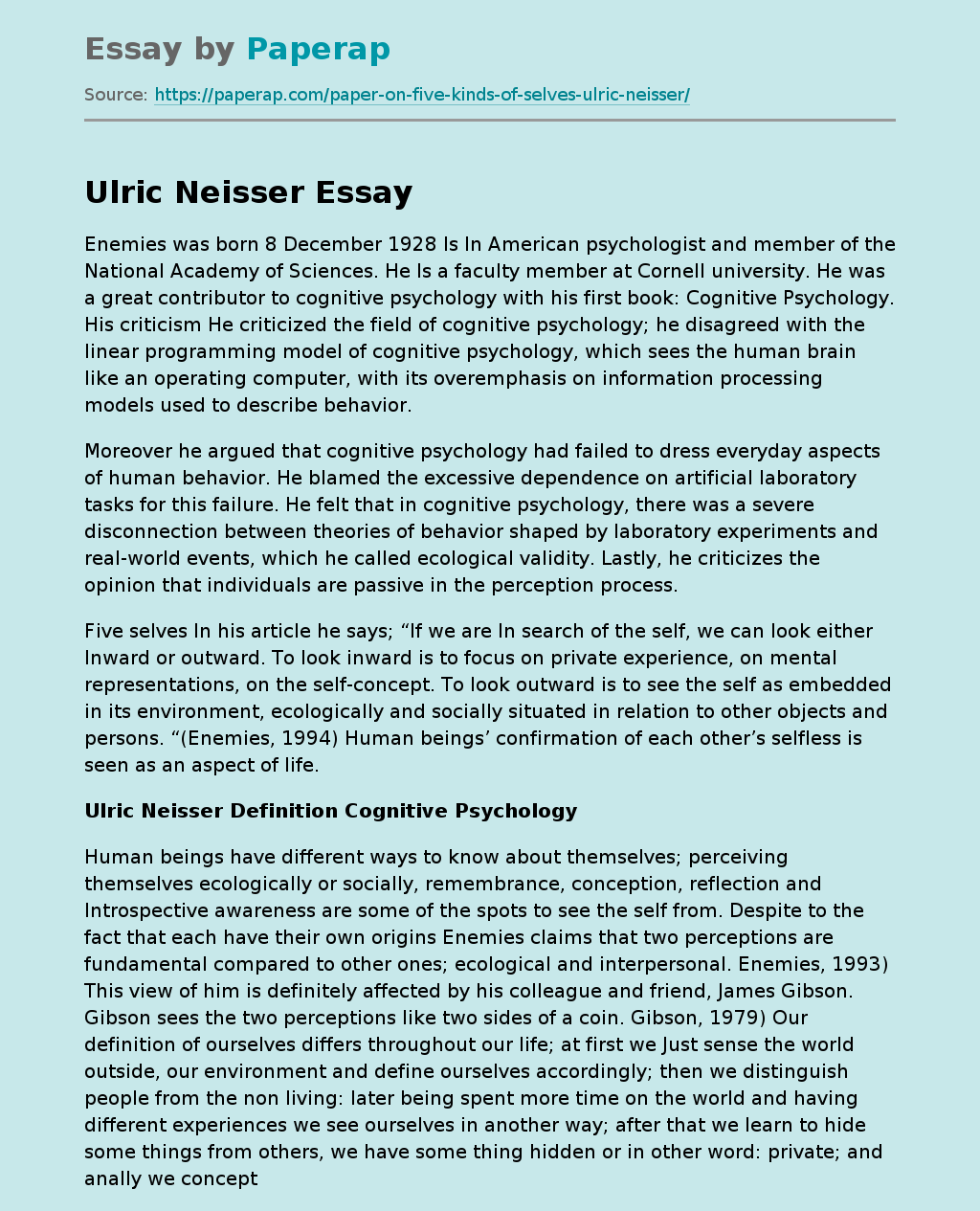Ulrik Neisser’s Definition of Cognitive Psychology
The following is an example of an essay about Ulrik Neisser’s definition of cognitive psychology. Read the introduction, body and conclusion of the essay, scroll down.
Enemies was born 8 December 1928 Is In American psychologist and member of the National Academy of Sciences. He Is a faculty member at Cornell university. He was a great contributor to cognitive psychology with his first book: Cognitive Psychology. His criticism He criticized the field of cognitive psychology; he disagreed with the linear programming model of cognitive psychology, which sees the human brain like an operating computer, with its overemphasis on information processing models used to describe behavior.
Moreover he argued that cognitive psychology had failed to dress everyday aspects of human behavior. He blamed the excessive dependence on artificial laboratory tasks for this failure. He felt that in cognitive psychology, there was a severe disconnection between theories of behavior shaped by laboratory experiments and real-world events, which he called ecological validity. Lastly, he criticizes the opinion that individuals are passive in the perception process.
Five selves In his article he says; “If we are In search of the self, we can look either Inward or outward. To look inward is to focus on private experience, on mental representations, on the self-concept. To look outward is to see the self as embedded in its environment, ecologically and socially situated in relation to other objects and persons. “(Enemies, 1994) Human beings’ confirmation of each other’s selfless is seen as an aspect of life.
Ulric Neisser Definition Cognitive Psychology
Human beings have different ways to know about themselves; perceiving themselves ecologically or socially, remembrance, conception, reflection and Introspective awareness are some of the spots to see the self from.
Despite to the fact that each have their own origins Enemies claims that two perceptions are fundamental compared to other ones; ecological and interpersonal. Enemies, 1993) This view of him is definitely affected by his colleague and friend, James Gibson. Gibson sees the two perceptions like two sides of a coin. Gibson, 1979) Our definition of ourselves differs throughout our life; at first we Just sense the world outside, our environment and define ourselves accordingly; then we distinguish people from the non living: later being spent more time on the world and having different experiences we see ourselves in another way; after that we learn to hide some things from others, we have some thing hidden or in other word: private; and anally we conceptualize a unique self. So Enemies defines five different selves according to the direction of the view; Ecological self “The self as perceived with respect to the physical environment. (l am the one here doing that. ) The limbs and the reach of them are always considered as ecological self; for example people with artificial body parts consider them as themselves’ because they move according to intentions and coordinated by the shifts in the viewpoint of the person. Interpersonal sell “The self that produces species specific signals of emotional relationship and communication. (l am the person engaging in this human relation. ) The ecological self is an active factor in the physical environment; the interpersonal self is an agent in a social environment.
We see/perceive ourselves as the target of the other persons’ attention, and as an agent in the interaction. Extended self “The self based on our personal memories and anticipations. ” (l am the one with certain experiences and certain routines. ) Private self “This self appears when children notice that some of their experiences are not directly shared with other people. ” (l am the one who can feel that unique emotion. ) Conceptual self (self concept) “The self drawing its meaning from the network of assumptions in which it is embedded.
It can be based on social roles, internal identities or personal characteristics. ” ( Enemies, 1988). I am an intelligent American professor. The conceptual self consists of the beliefs, appropriate roles, personal attributes, and even worth and value. Parallel to self concept there exist the self-narratives, the stories we tell to ourselves in mind, while encoding experiences to memory. (Enemies & Fichus, 1994). However we often tell the story to ourselves in a different way, reconstructing he life in our mind and this leads to another self; the remembered self.
His views about Perception Enemies argues that humans are not passive in cognition; they are active participants using their schemata to perceive the information flowing through sensory organs. If the information is relevant it may change the schemata and alter the processing of knowledge derived from the environment. Information action schemata Enemies believes that this conception explains selective perceptions; as the individual wanders throughout the world the schemata anticipates the beneficial information and allocates the resources to perceives it.
Ulrik Neisser’s Definition of Cognitive Psychology. (2019, Dec 05). Retrieved from https://paperap.com/paper-on-five-kinds-of-selves-ulric-neisser/

